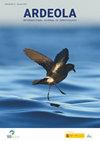一种迁徙的雀形鸟,普通芦莺的出发决定,与燃料负荷和地理屏障接近有关
IF 1.2
4区 生物学
Q2 ORNITHOLOGY
引用次数: 1
摘要
对候鸟中途停留生态学的研究考察了多种内在和外在因素对候鸟离开决策的影响。然而,一个单一的因素可能会对中途停留的决定产生不同的影响,这取决于中途停留地点在飞行路线内的相对地理位置和对未来生态挑战的预期。例如,在跨越主要地理障碍(如海洋或沙漠)之前,实际的燃料负荷可能对出发决定具有决定性影响,但在跨越提供大量加油机会的广阔大陆地区时,可能不那么重要。这里的目的是测试燃料负荷对长途迁徙鸣禽Acrocephalus scirpaceus的离场决定的相对影响,是否与地理屏障的接近程度有关:伊比利亚和非洲之间的海域。我们预计,从南部伊比利亚中途停留点出发将受到燃料负荷的严重影响,因为移民在有足够的燃料过海之前不会飞往非洲。我们使用Cormack-Jolly-Seber (CJS)模型测试了燃料负荷对秋季迁徙期间位于伊比利亚北部和南部的一些中途停留点的迁徙(离开)概率的影响。在伊比利亚北部停留超过一天的莺比在南部停留的莺更有可能离开。此外,大量装载的燃料促进了伊比利亚北部中转站的移民,而不是南部。因此,我们没有发现任何证据支持这样的假设,即芦莺会等到获得大量燃料后才离开屏障边缘附近的中途停留点。这项研究表明,相同的参数在迁移路线上可能不会以相同的方式起作用,特别是在地理屏障邻近方面。-Andueza, M., Barba, E., Cuenca, D., Laso, M., Unamuno, E., Unanue, A.,Valkenburg, T., Genovart, M.和Arizaga, J.(2020)。一种迁徙的雀形鸟,普通芦莺的出发决定,与燃料负荷和地理屏障的接近有关。本文章由计算机程序翻译,如有差异,请以英文原文为准。
Departure Decisions of a Migratory Passerine, the Common Reed-Warbler Acrocephalus scirpaceus, in Relation to Fuel Load and Geographical Barrier Proximity
Research on the stopover ecology of migrant birds has examined the role of multiple factors, both intrinsic and extrinsic, on departure decisions. However, a single factor may influence stopover decisions differentially, depending on the relative geographic location of a stopover site within the flyway and the expectation of ecological challenges ahead. For instance, actual fuel load may have a decisive influence on departure decisions before a crossing of major geographical barriers, such as seas or deserts, but may be less important when crossing vast continental areas offering plenty of opportunities to refuel. The aim here was to test whether the relative influence of fuel load on departure decisions of the Common Reed-warbler Acrocephalus scirpaceus, a long-distance migrant songbird, varies in relation to proximity to a geographical barrier: the sea expanse between Iberia and Africa. We expected that departure from southern Iberian stopover sites would be highly influenced by fuel load, since migrants would not fly to Africa until they had sufficient fuel to cross the sea. We used Cormack-Jolly-Seber (CJS) models to test for the effect of fuel load on emigration (departure) probability from a number of stopover sites situated in northern and southern Iberia during the autumn migration period. Reed-warblers stopping over for longer than one day were more likely to depart if they were in northern Iberia than in southern sites. Moreover, large fuel loads promoted emigration from stopover sites in northern, but not in southern, Iberia. Therefore, we found no evidence supporting the hypothesis that Reed-warblers wait until they acquire large fuel loads before leaving their stopover sites near the edge of the barrier. This study shows that the same parameters may not act in the same way along migration route, in particular in relation to geographical barrier proximity.—Andueza, M., Barba, E., Cuenca, D., Laso, M., Unamuno, E., Unanue, A.,Valkenburg, T., Genovart, M. & Arizaga, J. (2020). Departure decisions of a migratory passerine, the Common Reed-warbler Acrocephalus scirpaceus, in relation to fuel load and geographical barrier proximity.
求助全文
通过发布文献求助,成功后即可免费获取论文全文。
去求助
来源期刊
CiteScore
2.30
自引率
6.20%
发文量
16
审稿时长
>12 weeks
期刊介绍:
Ardeola: International Journal of Ornithology is the scientific journal of SEO/BirdLife, the Spanish Ornithological Society. The journal had a regional focus when it was first published, in 1954. Since then, and particular during the past two decades, the journal has expanded its thematic and geographical scope. It is now a fully international forum for research on all aspects of ornithology. We thus welcome studies within the fields of basic biology, ecology, behaviour, conservation and biogeography, especially those arising from hypothesis-based research. Although we have a long publication history of Mediterranean and Neotropical studies, we accept papers on investigations worldwide.
Each volume of Ardeola has two parts, published annually in January and July. The main body of each issue comprises full-length original articles (Papersand Review articles) and shorter notes on methodology or stimulating findings (Short Communications). The publication language is English, with summaries, figure legends and table captions also in Spanish. Ardeolaalso publishes critical Book Reviewsand PhD-Dissertation Summaries; summarising ornithological theses defended in Spain. Finally there are two Spanish-language sections, Ornithological News; summarising significant recent observations of birds in Spain, and Observations of Rare Birds in Spain, the annual reports of the Spanish Rarities Committee.

 求助内容:
求助内容: 应助结果提醒方式:
应助结果提醒方式:


